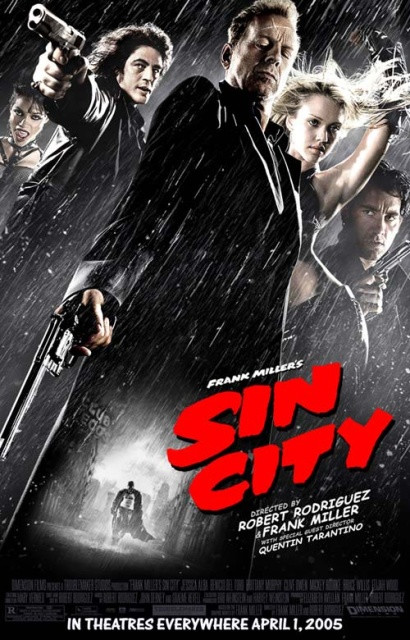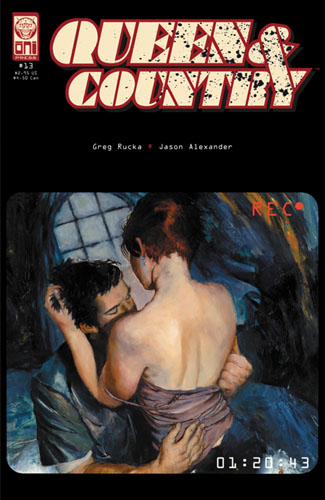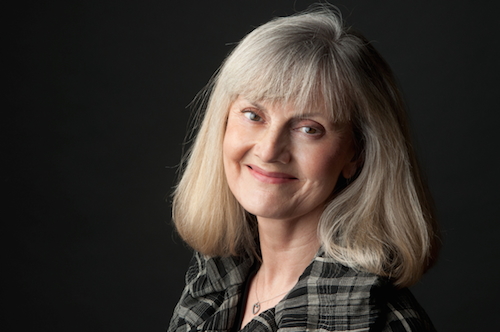
The American comic book industry is primarily known for its superheroes, colorful defenders of justice gifted with exotic powers. But in recent years, a small group of talented writers has broken new ground in one particular area: crime comics.
Crime and mystery fiction have always been represented in the comics. In the ’50s, some of the most extreme (and best) titles in the controversial EC Comics line fell into that category; more recently, Mickey Spillane contributed title and concepts to TeknoComix’s Mike Danger series, and Max Allan Collins has written both the Dick Tracy comic strip and the graphic novel The Road to Perdition, which spawned the recent hit film. And long-running comics characters like Batman and Daredevil have firm roots in the crime pulps of earlier decades.
But the comics medium is often considered a ghetto for kid’s stories, and “pure” crime tales have always been thin on the ground—until now. Over the past decade, six major crime series have made their mark, all, oddly, from different publishers. (Be warned: These are not comics for kids—many of them feature harsh language, violence, and nudity.)
 Sin City: “Nothing but that cold thing in my gut getting colder”
Sin City: “Nothing but that cold thing in my gut getting colder”
Frank Miller is one of the best-known and best-regarded creative people in the comic book field. He first made his name as writer/artist of an acclaimed run in Marvel’s Daredevil comic, then moved on to the graphic novel Ronin at DC Comics. But it was his grim, futuristic reimagining of Batman, The Dark Knight Returns, that made him a genuine pop culture superstar.
Sin City (Dark Horse), launched in 1992 in the small-circulation anthology Dark Horse Presents, is Miller’s most personal work. He writes, draws, and letters the stark black-and-white series himself, combining influences as diverse as pop art, grim dystopian science fiction, Japanese comics storytelling techniques, and Mickey Spillane novels. Sin City is set in a corrupt, vaguely futuristic city inhabited by damaged tough guys and sexually dangerous women, narrated by such prose as “It’s another hot night, dry and windless. The kind that makes people do sweaty, secret things.”
Miller has produced seven trade paperback volumes—most of which were previously published as individual comics—but the best Sin City remains the first. In it, a violent bruiser called Marv finds himself at the center of a scam when the beautiful woman he’s miraculously picked up turns up dead in the morning. Marv’s not the smartest guy in the world, but he knows enough to know when he’s being set up—and he doesn’t like it.
The artwork is half the show here; Miller renders the proceedings in a moody, noirish style, heavy on shadows and silhouettes and influenced by the slow, cinematic pacing of many Japanese comics. At times, Sin City falls into the kind of sexism that characterized too much of the ’50s hardboiled crime genre. But it’s always a stylish, fluid, fun read, and clearly the work of a top comics creator doing what he loves best.
 Powers: “Kaotic Chic”
Powers: “Kaotic Chic”
Brian Michael Bendis’ career route has been almost directly the opposite of Miller’s: He toiled away for years in comics’ small presses, honing a heavily film-influenced storytelling style, before moving on to Marvel Comics, where he currently writes Daredevil, Ultimate Spider-Man, and Alias (see below). But he hasn’t forgotten his indy-comics roots, and the ongoing series Powers (Image Comics) proves it.
Set in its own world of comic-book superheroes, Powers follows the exploits of Christian Walker and Deena Pilgrim, two homicide detectives specializing in cases involving “powers,” as the superheroes are popularly known. Complicating matters is Walker’s own past as a “power,” a part of his life he generally refuses to discuss.
Powers is structured as a police procedural, and largely driven by Bendis’s dialogue, which is both cinematic and unusually naturalistic for comics. Artist Michael Avon Oeming renders the proceedings in a very exaggerated style, heavily influenced by both pop art and animated cartoons. This quirky mixture accentuates the emotional reactions of the characters, and is particularly
effective in the climactic scenes, which often involve spectacular, pyrotechnic displays of superhuman power—in sharp contrast to the quiet, Chandleresque dialogue/character scenes that move the rest of the story along.
Much of Powers’ charm lies in the buddy-cop dynamic of the two central characters. Recently, Bendis has split them up, after Walker’s deliberately self-destructive exit from the police force. It’ll be interesting to see where Powers goes from here.
 100 Bullets: “Not everyone’s dead…some of ’em still workin’ on it”
100 Bullets: “Not everyone’s dead…some of ’em still workin’ on it”
The basic premise of 100 Bullets (DC Comics/Vertigo) is both simple and elegant: At the start of each story, the mysterious Agent Graves appears to someone who’s been wronged, handing him or her a gun, a hundred untraceable bullets, and full immunity from any illegal activity. The individual tales then follow the various characters as they take their revenge, decide against it, or come to their own untimely ends.
But Graves has his own reasons for giving out second chances, and over the past three years, writer Brian Azzarello has created a complex, slowly unfolding saga of worldwide conspiracies and hidden agendas. He’s also effectively fused the classic hard-boiled crime story with modern hip-hop settings and language, mixing young black and hispanic criminals with their older, Caucasian counterparts.
Eduardo Risso’s art is a smoky, atmospheric blend of European graphic album styles, with just a hint of some of the great Mad Magazine caricaturists like Angelo Torres & Jack Davis. Risso moves effortlessly from urban slums to strip clubs to hot tropical settings, never missing a beat. Brian Azzarello has become a hot comics writer in recent years, breathing new life into such series as DC/Vertigo’s Hellblazer and Marvel/Max’s Cage. But 100 Bullets remains his baby, and its ongoing storyline continues to gather characters and steam.
 alias: “I just want to feel something different”
alias: “I just want to feel something different”
At first glance, Alias (Marvel/Max; no relation to the TV series) bears a sharp resemblance to Powers, Brian Bendis’ other ongoing crime series. Both deal with crime investigations set in a world of superheroes, and both Powers’s Christian Walker and Alias’ Jessica Jones have super-powers of their own. But where Powers is a police procedural, Alias is a PI story; and Michael Gaydos’s dark, moody Alias art is a sharp contrast to Oeming’s bouncy Powers illustrations. This is deliberate, for Jessica Jones is a failed superhero, driven largely by doubt and a strong self-destructive streak.
There’s one other big difference: Where Power’s superheroes are cut from whole cloth, Alias is set right in the middle of Marvel Comics’ shared universe—which means it’s not unusual to find Jessica drawn into a conspiracy involving Captain America’s secret identity, or legally represented by Matt (Daredevil) Murdock. Or, in the series’ most notorious scene to date, engaged in self-loathing sex with ’70s blaxploitation character Luke Cage, Hero for Hire. But Alias isn’t a superhero story in drag; those elements are the icing, not the cake. Most of the book focuses on Jessica’s day-to-day investigations and interactions with a variety of people. As with the best fantastic fiction, the superhero elements serve as exaggerated metaphors for real-life situations.
Despite her generally bleak outlook on life, Jessica is a fascinating and often darkly witty character. And Alias deftly walks a fine line between being a pure PI tale and an offbeat Marvel comic, making it compelling reading for mystery fans and comics readers alike.
 Stray Bullets: “I think I saw someone get killed, but it was for real”
Stray Bullets: “I think I saw someone get killed, but it was for real”
David Lapham’s short comics resume consisted of just a handful of superhero comics, written by other people, when he launched the self-published Stray Bullets (El Capitan) in 1995 to immediate acclaim. Like 100 Bullets, Lapham’s similarly-titled series consists of individual character-centered tales that, taken together, form a much larger tapestry. As the stories hop back and forth through the past three decades, with characters weaving in and out, Stray Bullets paints a grand picture of multigenerational petty crime stretching across New York and New Jersey.
Stray Bullets is filled with vivid characters and unexpected twists. But Lapham really shines when focusing on children, such as Joey, whose neglectful mother and small-time-hood uncle inadvertently prepare him for a nervous life of crime; and Ginny, the abused, sporadically violent little girl who fantasizes, also very violently, about being a far-future master thief called Amy Racecar. Lapham draws the strip himself in a very straightforward style, reminiscent in many ways of classic adventure comic-strip art. But it’s also harrowing in its violence, whether he’s depicting a casual slap to a child’s face or a deliberate, grisly murder.
Lapham took a year-and-a-half break from Stray Bullets recently, during which he produced the also-interesting side-project Murder Me Dead. Since returning, he’s filled in some fascinating details in the lives of his large cast, and that’s sure to continue.
 queen & country: “It’s not the bullets that has your name on it you have to worry about...it’s all those other ones marked ‘To whom it may concern’”
queen & country: “It’s not the bullets that has your name on it you have to worry about...it’s all those other ones marked ‘To whom it may concern’”
Greg Rucka is an acclaimed crime novelist (Finder, Shooting at Midnight) as well as a comics writer. His interests come together most purely in Queen & Country (ONI Press), a fascinating, meticulously researched international espionage series focusing on a dirty-tricks division of British intelligence.
In the opening storyline, Tara Chace, a “Minder” for the Ministry of Intelligence, is dispatched to assassinate a Russian general for the greater good. Subsequent storylines have dealt with Chace’s psychological reactions to this act of cold-blooded murder, while moving the focus of the series to Middle East terrorism. In a story begun before 9/11, the Minders are sent to Afghanistan, where Rucka coldly exposes the brutality of the Taleban (as it’s spelled in the story), particularly its treatment of women. The following arc deals with the post-9/11 threat of a Sarin gas attack within England.
Queen & Country has had several different artists in its short run so far but the most stylish is the current one, newcomer Leandro Fernandez (who shares an art studio with 100 Bullets artist Eduardo Risso, a fellow Argentinian). Fernandez’s sexier, more buxom rendition of Tara Chace has been controversial among Q&C’s readers, but his expressive, exaggerated characters, keen sense of place, and slick rendering style give the book a unique look.
All grown up
All six of these series have appeared both as individual comic books and as collected hardcover & trade paperback editions, most of which are in print. They can be found in many Barnes & Noble stores or online at Amazon.com. A good comic book store is more likely to have current issues; local stores can be located by calling, toll-free, 1-888-COMIC-BOOK.
Readers who aren’t used to comic books sometimes find the form difficult to understand. But each of these series is written and drawn at a high level of craft, and the publishers have taken care to provide helpful recaps where appropriate. The other element the titles share is a focus on complex characterization, well beyond that found in most comics.
Which begs the question: Why have crime comics suddenly sprung up in such numbers, and at such a high level of quality? The answer seems to lie in the common interests of a talented group of writers and artists, many of whom are taking time from more lucrative work. And that’s the best answer readers could ask for.
Stuart Moore has been a book editor at St. Martin’s Press and a comics editor at both DC Comics, where he helped found the award-winning Vertigo imprint and edited such series as Preacher, Transmetropolitan, and Swamp Thing; and at Marvel, where he relaunched Captain America and edited series including Daredevil, The Punisher, Howard the Duck, and, yes, Alias. He won the Will Eisner award for Best Editor 1996 and the Don Thompson Award for Favorite Editor 1999. These days Stuart is a full-time writer; his science-fiction comic series Zendra is currently being published by PennyFarthing Press.



 "For me, the books I read were the call—the call to adventure, to thinking, to acknowledging other points of view. But to complete the ritual, I needed to respond."
"For me, the books I read were the call—the call to adventure, to thinking, to acknowledging other points of view. But to complete the ritual, I needed to respond." I am surrounded by books. Every room, every space in my large, sprawling 1750s house is full of books...
I am surrounded by books. Every room, every space in my large, sprawling 1750s house is full of books... Our history and experiences can define us, inspire our actions, and as writers impact our words and stories. Mine most definitely has: my father was a small-time gangster. Really.
Our history and experiences can define us, inspire our actions, and as writers impact our words and stories. Mine most definitely has: my father was a small-time gangster. Really. "My ah-ha moment came when I read The Great Gatsby, by F. Scott Fitzgerald.... That was it for me – I was off to the races."
"My ah-ha moment came when I read The Great Gatsby, by F. Scott Fitzgerald.... That was it for me – I was off to the races." Nietzsche once wrote, “There is always some madness in love. But there is also always some reason in madness.”
Nietzsche once wrote, “There is always some madness in love. But there is also always some reason in madness.” "Mystery books were daring and exciting, firing up my imagination and making me yearn to become a girl detective or even a secret agent. They also empowered me to make up impromptu ghost stories around the campfire for my Girl Scout troop and sneak into the cemetery at night on a dare."
"Mystery books were daring and exciting, firing up my imagination and making me yearn to become a girl detective or even a secret agent. They also empowered me to make up impromptu ghost stories around the campfire for my Girl Scout troop and sneak into the cemetery at night on a dare." Fire and Ashes, the latest Angela Richman Death Investigator mystery, is an exploration of a fatal fire. To research this novel, Viets delved into the devastating consequences of junk science and arson investigations.
Fire and Ashes, the latest Angela Richman Death Investigator mystery, is an exploration of a fatal fire. To research this novel, Viets delved into the devastating consequences of junk science and arson investigations.
